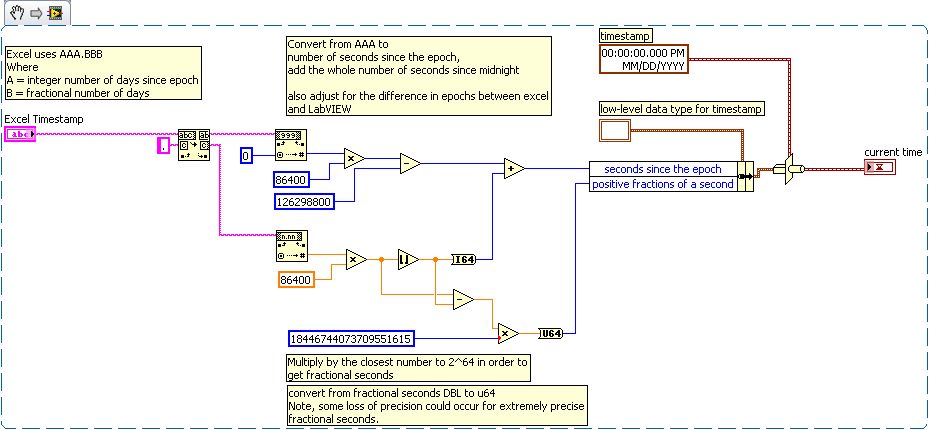- Subscribe to RSS Feed
- Mark Topic as New
- Mark Topic as Read
- Float this Topic for Current User
- Bookmark
- Subscribe
- Mute
- Printer Friendly Page
Converting Excel Timestamps to LabVIEW
12-31-2009 10:13 AM
- Mark as New
- Bookmark
- Subscribe
- Mute
- Subscribe to RSS Feed
- Permalink
- Report to a Moderator
From time to time, you may have the need to load timestamps from excel. You'll find out quickly that LabVIEW and Excel do not agree on a way to represent date/time!
LabVIEW Timestamp
http://zone.ni.com/devzone/cda/tut/p/id/7900
The LabVIEW timestamp is a 128-bit data type that represents absolute time. You can interpret this data type as a signed, 128-bit fixed-point number with a 64-bit radix.
{
(i64) seconds since the epoch 01/01/1904 00:00:00.00 UTC (using the Gregorian calendar and ignoring leap seconds),
(u64) positive fractions of a second
}
Excel Date and Times
http://www.ozgrid.com/Excel/ExcelDateandTimes.htm
Excel stores dates and times in the format: "X.Y" where X is the number of days since January 1, 1900 and Y is the fractional number of days since midnight of the date being represented. (0.0 represents midnight January 1 1900).
As a result, some serious data conversion needs to take place in order to get an Excel timestamp to be represented in LabVIEW.
I have written a VI which should do the trick. The operations performed are as follows:
1. Convert the X portion of the Excel date to seconds since 1/11900.
2. Adjust by the number of seconds between the Excel epoch and the LabVIEW epoch (126298800)
3. Add the number of seconds since midnight
4. Figure out how many fractional seconds have elapsed since the most recent second represented in the excel timestamp
5. Convert from fractional seconds to u64 as specified here: http://zone.ni.com/devzone/cda/tut/p/id/7900
6. Bundle the seconds and fractional seconds into a cluster which is compatible with the LabVIEW timestamp
7. Typecast the cluster into a LabVIEW timestamp
Voila.

If you notice any errors with this code, please leave a comment!
Evan
10-25-2010 10:02 AM
- Mark as New
- Bookmark
- Subscribe
- Mute
- Subscribe to RSS Feed
- Permalink
- Report to a Moderator
Neat. . It would have been even nicer if you had a utility to go the other way, to take a LV timestamp and output a number formated as per the Excel 1900 spec (or the optional Excel Mac spec as a 2nd choice). That would be handy for times when you want to store TSV or CSV files for use in Excel and you want an Excel compatible time-stamp. ![]()
Project Engineer
LabVIEW 2009
Run LabVIEW on WinXP and Vista system.
Used LabVIEW since May 2005
Certifications: CLD and CPI certified
Currently employed.
11-15-2010 04:49 PM
- Mark as New
- Bookmark
- Subscribe
- Mute
- Subscribe to RSS Feed
- Permalink
- Report to a Moderator
Thanks Evan, this is very useful! I'm surprised NI has allowed this to remain such a tedious operation.
12-14-2010 10:13 AM
- Mark as New
- Bookmark
- Subscribe
- Mute
- Subscribe to RSS Feed
- Permalink
- Report to a Moderator
Very good write-up and coding, couple thoughts:
- To support different regional settings it would be better to split by system decimal symbol, or treat as float and extract prime number...
- With Excel 2007+ "1904 date system" is now linked to workbook, rather than global Excel preference, so can back fire if work with various spreadsheets
-Artur
